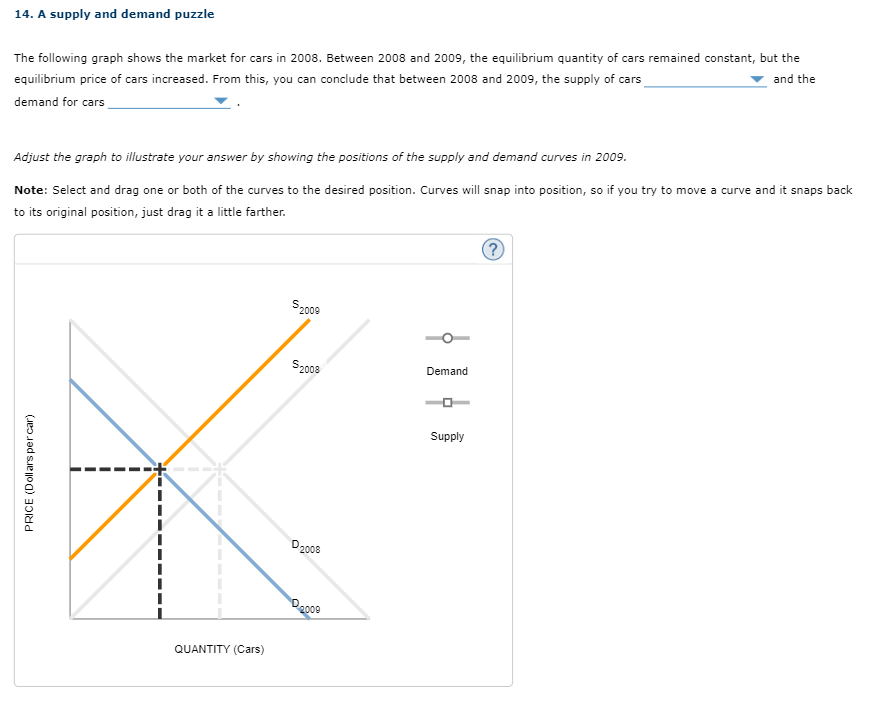The following graph shows the market for cars in 2008. Between 2008 and 2009, the equilibrium quantity of cars remained constant, but the and the equilibrium price of cars increased. From this, you can conclude that between 2008 and 2009, the supply of cars demand for cars Adjust the graph to illustrate your answer by showing the positions of the supply and demand curves in 2009. Note: Select and drag one or both of the curves to the desired position. Curves will snap into position, so if you try to move a curve and it snaps back to its original position, just drag it a little farther. S2000 S2008 Demand Supply D2008 2009 QUANTITY (Cars) PRICE (Dollars percar)
The following graph shows the market for cars in 2008. Between 2008 and 2009, the equilibrium quantity of cars remained constant, but the and the equilibrium price of cars increased. From this, you can conclude that between 2008 and 2009, the supply of cars demand for cars Adjust the graph to illustrate your answer by showing the positions of the supply and demand curves in 2009. Note: Select and drag one or both of the curves to the desired position. Curves will snap into position, so if you try to move a curve and it snaps back to its original position, just drag it a little farther. S2000 S2008 Demand Supply D2008 2009 QUANTITY (Cars) PRICE (Dollars percar)
Principles of Microeconomics
7th Edition
ISBN:9781305156050
Author:N. Gregory Mankiw
Publisher:N. Gregory Mankiw
Chapter4: The Market Forces Of Supply And Demand
Section: Chapter Questions
Problem 8PA
Related questions
Question

Transcribed Image Text:14. A supply and demand puzzle
The following graph shows the market for cars in 2008. Between 2008 and 2009, the equilibrium quantity of cars remained constant, but the
and the
са
equilibrium price of cars increased. From this, you can conclude that between 2008 and 2009, the supply of cars
demand for cars
Adjust the graph to illustrate your answer by showing the positions of the supply and demand curves in 2009.
Note: Select and drag one or both of the curves to the desired position. Curves will snap into position, so if you try to move a curve and it snaps back
to its original position, just drag it a little farther.
(?
S2009
S2003
Demand
Supply
D2008
D2009
QUANTITY (Cars)
PRICE (Dollars percar)
Expert Solution
This question has been solved!
Explore an expertly crafted, step-by-step solution for a thorough understanding of key concepts.
This is a popular solution!
Trending now
This is a popular solution!
Step by step
Solved in 2 steps

Knowledge Booster
Learn more about
Need a deep-dive on the concept behind this application? Look no further. Learn more about this topic, economics and related others by exploring similar questions and additional content below.Recommended textbooks for you

Principles of Microeconomics
Economics
ISBN:
9781305156050
Author:
N. Gregory Mankiw
Publisher:
Cengage Learning

Microeconomics: Principles & Policy
Economics
ISBN:
9781337794992
Author:
William J. Baumol, Alan S. Blinder, John L. Solow
Publisher:
Cengage Learning

Economics Today and Tomorrow, Student Edition
Economics
ISBN:
9780078747663
Author:
McGraw-Hill
Publisher:
Glencoe/McGraw-Hill School Pub Co

Principles of Microeconomics
Economics
ISBN:
9781305156050
Author:
N. Gregory Mankiw
Publisher:
Cengage Learning

Microeconomics: Principles & Policy
Economics
ISBN:
9781337794992
Author:
William J. Baumol, Alan S. Blinder, John L. Solow
Publisher:
Cengage Learning

Economics Today and Tomorrow, Student Edition
Economics
ISBN:
9780078747663
Author:
McGraw-Hill
Publisher:
Glencoe/McGraw-Hill School Pub Co

Principles of Economics 2e
Economics
ISBN:
9781947172364
Author:
Steven A. Greenlaw; David Shapiro
Publisher:
OpenStax

Exploring Economics
Economics
ISBN:
9781544336329
Author:
Robert L. Sexton
Publisher:
SAGE Publications, Inc

Brief Principles of Macroeconomics (MindTap Cours…
Economics
ISBN:
9781337091985
Author:
N. Gregory Mankiw
Publisher:
Cengage Learning